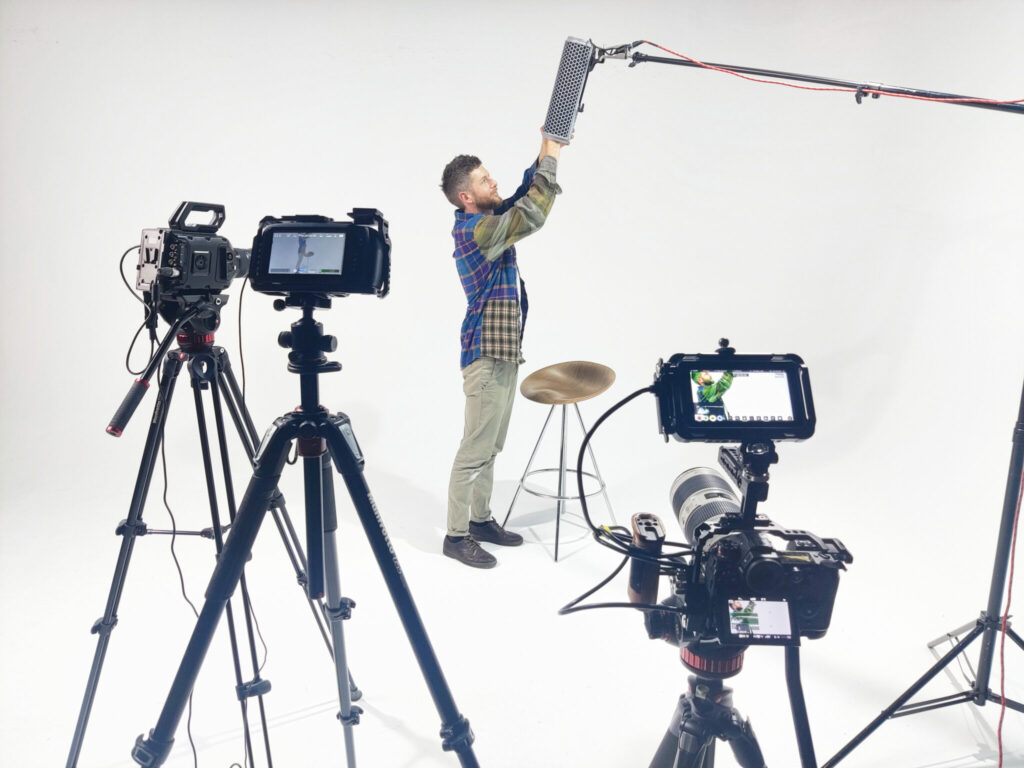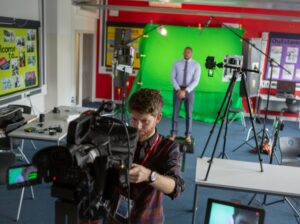 Picture the scene: you’ve been positioned in front of several cameras, a boom mic is fixed inches above your head, two bright lights are spotlighting you from either side, and a third one behind you. A lav mic is clipped on your collar, the record button has been pressed and.. you want the ground to swallow you.
Picture the scene: you’ve been positioned in front of several cameras, a boom mic is fixed inches above your head, two bright lights are spotlighting you from either side, and a third one behind you. A lav mic is clipped on your collar, the record button has been pressed and.. you want the ground to swallow you.
For some, delivering lines on camera is as effortless as breathing, while for others, it can be a nerve-wracking experience. If you fall into the latter category, fear not! In this blog post, we’ll share five valuable tips to help you prepare for the moment the clapperboard claps.
1. Master your material.
It may seem obvious, but if you feel comfortable with your subject matter then that will come across on camera. Instead of simply memorising lines about a topic you’re not well-acquainted with, take the time to truly understand and internalise it before the shoot. Your comfort and expertise will naturally radiate on screen.
2. Embrace the environment
The camera setup can be intimidating, with lights and microphones everywhere. However, instead of viewing these elements as sources of stress, embrace them as tools to enhance your performance. The bright lights illuminate you, making you the centre of attention. The microphones ensure your voice is crystal clear. Recognise these elements as aids, not adversaries.
3. Breeeeaaaathe and stay present
Nerves often lead to shallow breathing, which can affect your voice and composure on camera. To combat this, practice deep, calming breaths before and during your shoot. Focus on being present in the moment, rather than dwelling on potential mistakes. Remember that pauses and moments of silence can be powerful on camera, allowing your audience to absorb your message. Whilst you may be thinking: “Do I look as nervous as I feel?”, entertaining those thoughts really isn’t useful and may result in you freezing up. So try to just focus on your subject matter.
 4. Also embrace post-production magic
4. Also embrace post-production magic
Here’s a comforting thought: unless you’re on live television, your delivery doesn’t need to be flawless. It’s easy to become fixated on articulating everything concisely and with pinpoint accuracy, but the reality is that minor verbal hiccups like ‘ums’ and ‘ahs’ can be easily polished out during post-production.
Even if your sentences don’t initially make perfect sense, the magic of post-production allows us to rearrange words and snippets to create a seamless final product. It’s all part of the process, and you’re not alone in this.
Additionally, keep in mind that in most cases, interviews and scripted deliveries, such as talking heads, are often interspersed with cutaway footage in the final film. This means that any minor imperfections or pauses can be masked by visual content, ensuring a smooth and engaging viewing experience.
Perfection isn’t the goal; conveying your message authentically is what truly matters. Post-production is there to lend its magic and make you shine even brighter!
5. Be you.
Our advice is simple: be yourself. Speak as if you’re having a casual conversation with a friend or colleague. When you adopt a natural, conversational tone, it comes across as more authentic and less forced.
It’s important to recognise that, like many things in life, any anxiety leading up to being on camera is often more daunting than the actual experience itself. Our team understands that stepping in front of the camera can be intimidating for some people, which is why we make every effort to create a relaxed and supportive environment when the record button is pressed. We’re a friendly bunch and we get it.
 Additionally, we offer autocue technology on all our shoots, providing an extra layer of assistance to ensure your delivery is smooth and confident.
Additionally, we offer autocue technology on all our shoots, providing an extra layer of assistance to ensure your delivery is smooth and confident.
So, remember, when you’re in front of the camera, just be yourself, and the authenticity of your delivery will shine through, making for a more engaging and relatable on-screen presence.
In conclusion, being comfortable in front of the camera is a skill that can be honed with practice and a deep understanding of your subject matter. By mastering your material, practicing diligently, embracing your environment, and staying present, you’ll find that being on camera becomes a much more enjoyable and confident experience. So, the next time the clapperboard claps, you’ll be ready to shine!

